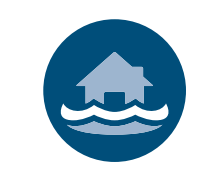
According to FEMA, flooding is the most common natural disaster in the United States and can occur in
any region at any time. Use this guide and checklist to prepare your business and employees for a flood.
KNOW THE TERMS
- Flood watch: Flooding is possible. Tune into local weather stations for additional
information. - Flash Flood Watch: Flash flooding is possible. Prepare to move to
higher ground and continue to monitor local weather channels
for updates. - Flood Warning: Flooding is occurring or will occur soon. If advised
to evacuate, do so immediately. - Flash Flood Warning: A flash flood is occurring. Seek higher ground
on foot immediately.
KNOW YOUR AREA’S FLOOD RISK
- Coastal Regions: According to FEMA, coastal areas are at greater risk of flooding during hurricane season
(June- November). - Midwest Regions: Flooding is more common during the Spring and Summer, while the Southwest is at risk
during summer monsoon season. - Northeast and Northwest: Typically, these areas are most at risk of flooding during ice jams in the Spring.
- Slosh Map: For more information on how hurricane activity could lead to flooding in your area, take a look at
this Slosh map from the National Hurricane Center (NHC).
DRIVING SAFETY
- Know the limits of your vehicle when driving and don’t put you or your passengers at risk.
- Six inches of water will reach the bottom of most passenger cars causing loss of control and possible
stalling. - A foot of water will float most vehicles, and two feet of water can carry away most vehicles including SUVs
and pick-ups.
ADDITIONAL TOOLS AND RESOURCES
- Preparing Your Business for the Unthinkable Disaster Overview from the American Red Cross
- Business Disaster Planning Checklist from the American Red Cross
- FEMA’s Flood Preparedness Guide
- FEMA’s Small Business Disaster Resources Toolkit

